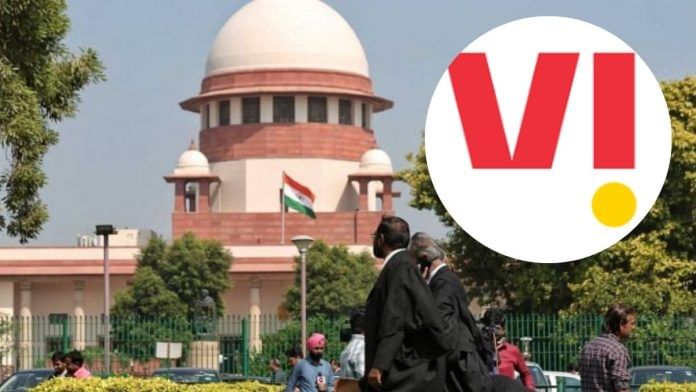New Delhi: Beleaguered telecom operator Vodafone Idea got significant relief this week when the Supreme Court allowed the government to reassess the company’s adjusted gross revenue (AGR) dues up to 2016–17, effectively opening a narrow but crucial window for the cash-strapped telco to potentially reduce its massive liabilities.
The dispute over the definition of “gross revenue”—the base on which telecom operators pay license fees and spectrum usage charges—reached the top court following efforts by Vodafone Idea to convince the government that the calculations of the Department of Telecommunications (DoT) were full of mathematical and accounting errors.
What the case is about
The case goes back to the shift from the fixed license-fee model to the revenue-sharing regime introduced under the National Telecom Policy (NTP) 1999.
Earlier, operators had to pay a hefty annual fee, often hundreds of crores, regardless of revenue, under the National Telecom Policy (NTP) 1994.
The model put significant pressure on the finances of telcos, as at the time, call rates were high, mobile penetration was minuscule (less than one percent), and networks were expensive to build.
But in 1999, the government changed the policy and telecom operators had to pay license fees based on their revenues.
Herein lay the roots of the dispute. Telecom companies and the DoT disagreed over what counts as “revenue” when calculating license fees. Telcos said only money from core services—calls, data and SMSes—should be included in the AGR. But the DoT insisted it covered everything, including rent, interest or profit from selling old towers.
In 2019, the Supreme Court agreed with the government. Overnight, the liabilities of companies like Vodafone Idea and Airtel ballooned into tens of thousands of crores. As of March 2025, the dues had grown to Rs 83,400 crore.
For Vodafone Idea, that verdict was a near-death sentence. Since then, it has been pressing the government to revisit the DoT’s definition of AGR saying it was full of errors, such as double-counting and including interest on interest.
AGR is the figure on which telcos pay license fees (8 percent of AGR) and spectrum usage charges (3-5% of AGR).
What Supreme Court said and why it matters
The Supreme Court has modified its earlier 2019 order, permitting the government to undertake a full reassessment of Vodafone Idea’s AGR dues up to 2016-17. Significantly, the relief only applies to Vodafone Idea; other operators will not be able to claim this benefit.
The court clarified that the decision to review the calculations lay with the government. The order does not waive dues, but it allows the Centre to revisit, recalculate or rationalise them, potentially offering big relief.
The order represents a subtle shift.
Back in 2019, the Supreme Court took a tough line, saying telcos had no business questioning how dues were calculated. That verdict nearly broke the sector. Now, six years later, the same court is signalling that the government must be allowed to be flexible and take decisions that protect economic stability and competition.
This reflects a change in the government’s own posture too. The government, which once insisted on full recovery, is now effectively being told it can prioritise sectoral health over strict collections.
The latest court order is critical for the telecom industry because Vodafone Idea’s survival isn’t just about one company, but it’s also about keeping the market from becoming a duopoly.
If Vodafone Idea collapses, India will be left with just two private players, Jio and Airtel, creating a virtual duopoly. Prices would eventually rise, and the government, which is a shareholder in Vodafone Idea, would lose both an operator and an investment. The government owns about 49 percent of Vodafone Idea after a debt-to-equity conversion.
The government converted Vodafone Idea’s dues into equity in two stages. In February 2023, it approved converting Rs 16,133 crore of interest liabilities, becoming a key shareholder. On 29 March this year, it converted another Rs 36,950 crore of spectrum dues, raising its stake to nearly 49 percent. This completed the two-phase process that began in 2023 and concluded with the major conversion in 2025.
Why is only Vodafone facing this issue
Vodafone Idea’s AGR dues are the highest due to legacy liabilities and years of compounding.
After the 2018 merger of Vodafone India and Idea Cellular, the new entity inherited dues from both companies, with no waivers allowed by the Supreme Court.
Interest of 12-16 percent, penalties of about 50 percent and interest on penalties over nearly two decades inflated the dues. Unlike Jio, which had no pre-2016 exposure, and Airtel, which made partial payments early, Vodafone and Idea delayed payments entirely, causing their liabilities to multiply sharply.
What happens next
A key question now is how the DoT handles the recalculation—whether it conducts a reassessment of Vodafone Idea’s AGR dues or merely reaffirms earlier figures.
The industry is keeping close tabs on the case, and Airtel may seek a similar review.
Another question is how dues beyond FY17 will be treated, since the current order covers only up to that year.
Finally, this case could revive discussions on a broader telecom relief framework, as the government has been considering sector-wide restructuring of legacy dues to ensure long-term industry stability.
Banudas Athreya is a TPSJ alum, currently interning with ThePrint.
(Edited by Sugita Katyal)
Also Read: Gurugram unauthorised construction case: In rap to HC, why Supreme Court cited procedural fairness






